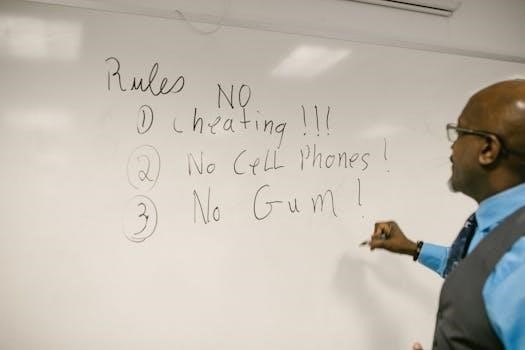Hoover SmartWash Instructions⁚ A Comprehensive Guide
Welcome to your comprehensive guide to mastering the Hoover SmartWash! This guide provides clear, step-by-step instructions for optimal use and maintenance․ Whether you’re a new owner or seeking troubleshooting advice, this is your essential resource․

Understanding Your Hoover SmartWash
The Hoover SmartWash is designed for ease of use and efficient carpet cleaning․ It eliminates guesswork with Automatic Cleaning Technology, making carpet cleaning as simple as vacuuming․ The SmartWash automatically applies and mixes the correct amount of solution, removing the need for manual measuring․ To clean, simply push forward; to dry, pull back․ No triggers or multiple buttons are involved, streamlining the process․
This carpet cleaner is equipped with separate clean and dirty water tanks․ It features a removable nozzle for easy cleaning and maintenance․ Some models, like the SmartWash Pet Complete, include a pretreat wand for tackling tough stains; To maximize performance, understand the specific features of your model, such as the FlexForce PET PowerBrushes for pet owners․ The SmartWash offers both wash and dry modes, indicated by LED displays․ Regular filter maintenance and proper tank emptying are crucial․
Familiarizing yourself with these features is key to achieving optimal cleaning results and extending the life of your Hoover SmartWash․
Key Features of the Hoover SmartWash
The Hoover SmartWash boasts several key features designed for efficient and user-friendly carpet cleaning․ Automatic Cleaning Technology eliminates the guesswork, dispensing the correct amount of solution as you clean․ The triggerless design allows for seamless switching between washing and drying modes by simply pushing forward to wash and pulling back to dry․ Separate clean and dirty water tanks ensure optimal cleaning performance․
Some models, like the SmartWash Pet Complete, feature specialized tools such as the Removable Spot Chaser Pretreat Wand for targeted stain removal and FlexForce PET PowerBrushes, tailored for pet owners․ The automatic wash/dry LED display provides clear operational status․ Additionally, a removable recovery nozzle simplifies cleaning and maintenance․ A carry handle enhances portability, and the solution tank is easy to fill․
The SmartWash also includes a filter to protect the motor and a hose connection for attachments (model dependent)․ Understanding these features will enable you to effectively utilize the SmartWash for a cleaner home․
Getting Started⁚ Pre-Cleaning Preparations
Before using your Hoover SmartWash, proper pre-cleaning preparations are crucial for optimal results․ Begin by thoroughly vacuuming the area you intend to clean․ This removes loose dirt, debris, and pet hair, preventing them from clogging the SmartWash and ensuring a more effective deep clean․
Next, identify and pretreat any stubborn stains or heavily soiled areas․ Use a stain remover specifically designed for carpets and follow the manufacturer’s instructions․ For SmartWash Pet Complete models, utilize the Removable Spot Chaser Pretreat Wand․ Test the stain remover in an inconspicuous area first to ensure it doesn’t discolor the carpet․
Ensure the area is clear of furniture and other obstacles․ Secure any loose rugs or items that could be caught by the SmartWash․ Good ventilation is essential, so open windows or use fans to promote airflow, speeding up the drying process․ By taking these preparatory steps, you’ll maximize the cleaning power of your Hoover SmartWash and achieve a noticeably cleaner carpet․
Filling the Water and Solution Tanks
Properly filling the water and solution tanks is essential for the Hoover SmartWash to function effectively․ Start by locating the clean water tank, typically marked and easily removable․ Fill it with warm tap water to the indicated fill line․ Avoid using hot water, as it may damage the machine․ Never overfill the tank․
Next, locate the solution tank․ Determine the appropriate amount of carpet cleaning solution based on the size of the area you intend to clean and the solution manufacturer’s instructions․ Many SmartWash models feature automatic solution mixing, eliminating the need for manual measuring․ Pour the carpet cleaning solution into the solution tank, again avoiding overfilling․
Ensure both tanks are securely attached to the SmartWash before operation․ An improperly attached tank can lead to leaks and reduced cleaning performance․ Refer to your SmartWash model’s user manual for specific tank locations and filling instructions, as tank designs may vary slightly․ With the tanks correctly filled, your SmartWash is ready to tackle dirty carpets․
Operating the Hoover SmartWash⁚ Cleaning Mode
Activating the cleaning mode on your Hoover SmartWash is designed for simplicity and efficiency․ Ensure both the clean water and solution tanks are adequately filled before commencing․ Plug the SmartWash into a grounded electrical outlet․ Most models feature an automatic cleaning technology; simply push the machine forward to dispense cleaning solution and wash the carpet, then pull it back to dry․

There’s no need to hold down a trigger, which makes the process effortless․ Maintain a slow and steady pace to allow the brushes to effectively agitate and lift dirt from the carpet fibers․ Overlap each cleaning path slightly to ensure thorough coverage․ For heavily soiled areas, repeat the process, applying slightly more pressure on the forward pass․
Avoid soaking the carpet excessively․ The SmartWash is engineered to extract water efficiently, but excessive saturation can prolong drying time․ Monitor the dirty water tank and empty it when it reaches its maximum capacity․ Once you’ve covered the desired area, proceed to the drying mode for optimal results․

Operating the Hoover SmartWash⁚ Drying Mode
Transitioning to drying mode on your Hoover SmartWash is seamless․ After completing the cleaning pass, simply continue using the machine in a backward motion․ The SmartWash is engineered to extract remaining water from the carpet during this phase, accelerating the drying process․ Ensure you maintain a consistent, slow speed as you pull the machine back․
This allows the suction to effectively lift moisture from the carpet fibers․ Overlap your drying paths just as you did during the cleaning phase to ensure uniform drying across the treated area․ For areas that remain particularly damp, repeat the drying process several times․ Keep an eye on the dirty water tank, as additional water may be extracted during this phase․
Empty the tank as needed․ Proper ventilation in the room will further aid in the drying process; open windows or use fans to circulate air․ Avoid walking on the cleaned carpet until it is completely dry to prevent re-soiling․ The drying mode optimizes the SmartWash’s performance and minimizes downtime․
Cleaning and Maintaining the Hoover SmartWash
Proper cleaning and maintenance are crucial for extending the life and performance of your Hoover SmartWash․ After each use, it is essential to empty the dirty water tank․ Rinse the tank thoroughly to remove any remaining debris or residue․ Pay close attention to the filter; remove it and wash it under running water․ Allow the filter to air dry completely before reinstalling it to prevent mold growth․
The nozzle and brushes should also be cleaned regularly․ Remove any hair or fibers that may be tangled around the brushes․ Use a damp cloth to wipe down the exterior of the machine, removing any spills or dirt․ Periodically check the hose for any blockages and clear them as needed․
Store the SmartWash in a dry place to prevent corrosion or damage․ By following these maintenance steps, you ensure that your Hoover SmartWash remains in optimal condition for future cleaning tasks․ Regular upkeep not only improves performance but also prevents costly repairs down the line․
Emptying the Dirty Water Tank
Emptying the dirty water tank is a crucial step in maintaining your Hoover SmartWash, ensuring optimal performance and preventing unpleasant odors․ After each cleaning session, detach the dirty water tank from the main unit․ This tank, also known as the recovery tank, collects all the dirty water and debris extracted from your carpets․

Carefully carry the tank to a sink or drain to avoid spills․ To empty the tank, locate the release latch or opening, and pour the dirty water out․ Rinse the tank thoroughly with clean water to remove any remaining sediment or residue․ For stubborn dirt, you can use a mild detergent and a brush to scrub the inside of the tank․ Ensure all traces of soap are removed before reassembling․
Allow the tank to air dry completely before reattaching it to the SmartWash․ This prevents mold and mildew growth․ Regular emptying and cleaning of the dirty water tank will keep your Hoover SmartWash functioning efficiently and extend its lifespan․ Ignoring this step can lead to clogs, reduced suction power, and unpleasant smells․
Cleaning the Nozzle and Brushes
Maintaining clean nozzles and brushes is vital for the effective operation of your Hoover SmartWash․ Over time, these components can accumulate dirt, hair, and fibers, hindering their ability to clean carpets properly․ Regular cleaning ensures optimal performance and extends the life of your SmartWash․
Start by detaching the nozzle from the SmartWash․ Refer to your user manual for specific instructions on how to remove it safely․ Once detached, rinse the nozzle thoroughly under running water to remove loose debris․ Use a small brush or toothbrush to scrub away any stubborn dirt or buildup․ Pay close attention to any small openings or crevices where dirt might be trapped;
Next, focus on the brushes․ Depending on your model, the brushes may be removable․ If so, detach them and remove any tangled hair, threads, or fibers․ Use scissors or a seam ripper to carefully cut and remove stubborn tangles․ Wash the brushes with mild soap and water, ensuring all soap residue is rinsed away․ Allow both the nozzle and brushes to air dry completely before reassembling them onto your Hoover SmartWash․ Regular cleaning will keep your SmartWash performing at its best, delivering consistently clean carpets․
Filter Maintenance
Maintaining the filter of your Hoover SmartWash is crucial for its optimal performance and longevity․ The filter traps dirt, dust, and debris, preventing them from entering the motor and causing damage․ A clean filter ensures strong suction and efficient cleaning․ Regular maintenance will help your SmartWash operate effectively․
Locate the filter compartment on your Hoover SmartWash․ Refer to your user manual for the exact location, as it may vary slightly depending on the model․ Open the compartment and remove the filter․ Inspect the filter for any visible dirt or debris․ Gently tap the filter over a trash can to dislodge loose particles․
For a more thorough cleaning, wash the filter with mild soap and water․ Ensure that all soap residue is rinsed away completely․ Allow the filter to air dry fully before placing it back into the SmartWash․ Never operate the SmartWash without a filter in place, as this can cause damage to the motor․ Depending on usage, consider replacing the filter every few months to maintain peak performance․ Clean the filter regularly to keep your Hoover SmartWash running smoothly and efficiently, ensuring your carpets stay clean and fresh․
Troubleshooting Common Issues
Even with proper use and maintenance, you may encounter occasional issues with your Hoover SmartWash․ Addressing these problems promptly can prevent further damage and ensure your carpet cleaner continues to perform effectively․ Here are some common issues and troubleshooting steps․
Suction Problems⁚ If you notice a decrease in suction, first check the dirty water tank․ An overfull tank can restrict airflow․ Next, inspect the hose and nozzle for clogs․ Remove any debris or obstructions that may be blocking the airflow․ Ensure the filter is clean and properly installed, as a dirty filter can significantly reduce suction power․
Solution Dispensing Issues⁚ If the SmartWash is not dispensing solution, check the solution tank to ensure it is filled․ Verify that the tank is properly seated and the cap is securely tightened․ Inspect the solution hose for kinks or obstructions․ If the problem persists, try priming the pump by running the SmartWash in a small area for a few minutes․
Brush Roll Stoppage⁚ If the brush rolls stop spinning, turn off the SmartWash and unplug it․ Check for tangled hair or debris around the brush rolls․ Remove any obstructions and ensure the brush rolls can move freely․ If the problem continues, consult the user manual or contact Hoover customer support for further assistance․ By addressing these common issues promptly, you can keep your Hoover SmartWash in excellent working condition․
Addressing Suction Problems
Loss of suction in your Hoover SmartWash can significantly impact its cleaning performance․ Before assuming a major malfunction, there are several troubleshooting steps you can take to identify and resolve the issue․
Check the Dirty Water Tank⁚ An overly full dirty water tank is a common cause of reduced suction․ Empty the tank and ensure it is properly seated․ The SmartWash is designed to stop suction when the tank reaches capacity to prevent overflow․
Inspect the Hose and Nozzle⁚ Blockages in the hose or nozzle can severely restrict airflow․ Disconnect the hose and nozzle and carefully inspect them for any obstructions, such as hair, debris, or tangled fibers․ Use a long, flexible tool to remove any blockages․
Clean the Filters⁚ Clogged filters can significantly reduce suction power․ Locate the filters, typically near the dirty water tank, and remove them․ Wash the filters with warm water and allow them to dry completely before reinstalling․ Ensure the filters are properly seated for optimal performance․
Check Brush Roll Area⁚ Debris accumulation around the brush rolls can sometimes affect suction indirectly․ Clean the brush roll area, removing any tangled hair or fibers that may be obstructing airflow․ By systematically checking these components, you can often restore your SmartWash’s suction power․
Dealing with Solution Dispensing Issues
If your Hoover SmartWash isn’t dispensing cleaning solution properly, it can lead to ineffective carpet cleaning․ Fortunately, there are several steps you can take to diagnose and fix the problem․
Verify Solution Tank Levels⁚ The most common issue is simply an empty or low solution tank․ Ensure the tank is filled with the appropriate cleaning solution, following the manufacturer’s recommendations for dilution․ Avoid using excessive amounts of solution, as this can lead to residue buildup․
Check Tank Placement⁚ Make sure the solution tank is correctly inserted and securely locked into place․ A misaligned tank can prevent the solution from being drawn into the system․
Inspect the Solution Hose and Nozzle⁚ Blockages in the solution hose or nozzle can prevent the solution from being dispensed․ Detach the hose and nozzle and inspect them for any clogs or debris․ Use a small brush or pin to clear any obstructions․
Clean the Solution Filter⁚ Some SmartWash models have a small filter in the solution tank or hose․ This filter can become clogged over time, restricting solution flow․ Remove and clean the filter with warm water․
Test the Dispensing Mechanism⁚ With the solution tank filled and properly installed, activate the SmartWash in a test area․ Observe whether the solution is being dispensed evenly and consistently․ If not, repeat the previous steps or consult the Hoover support resources․